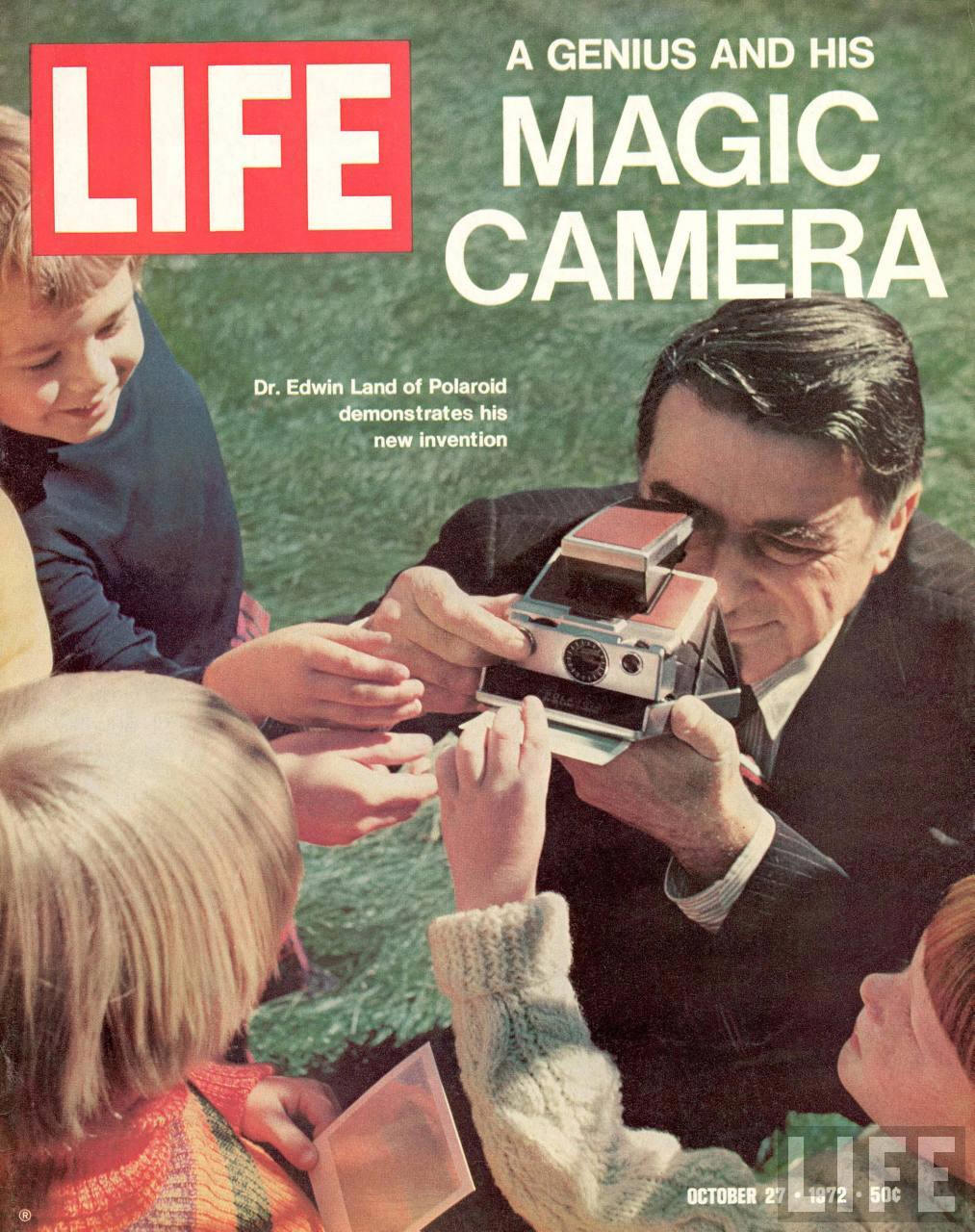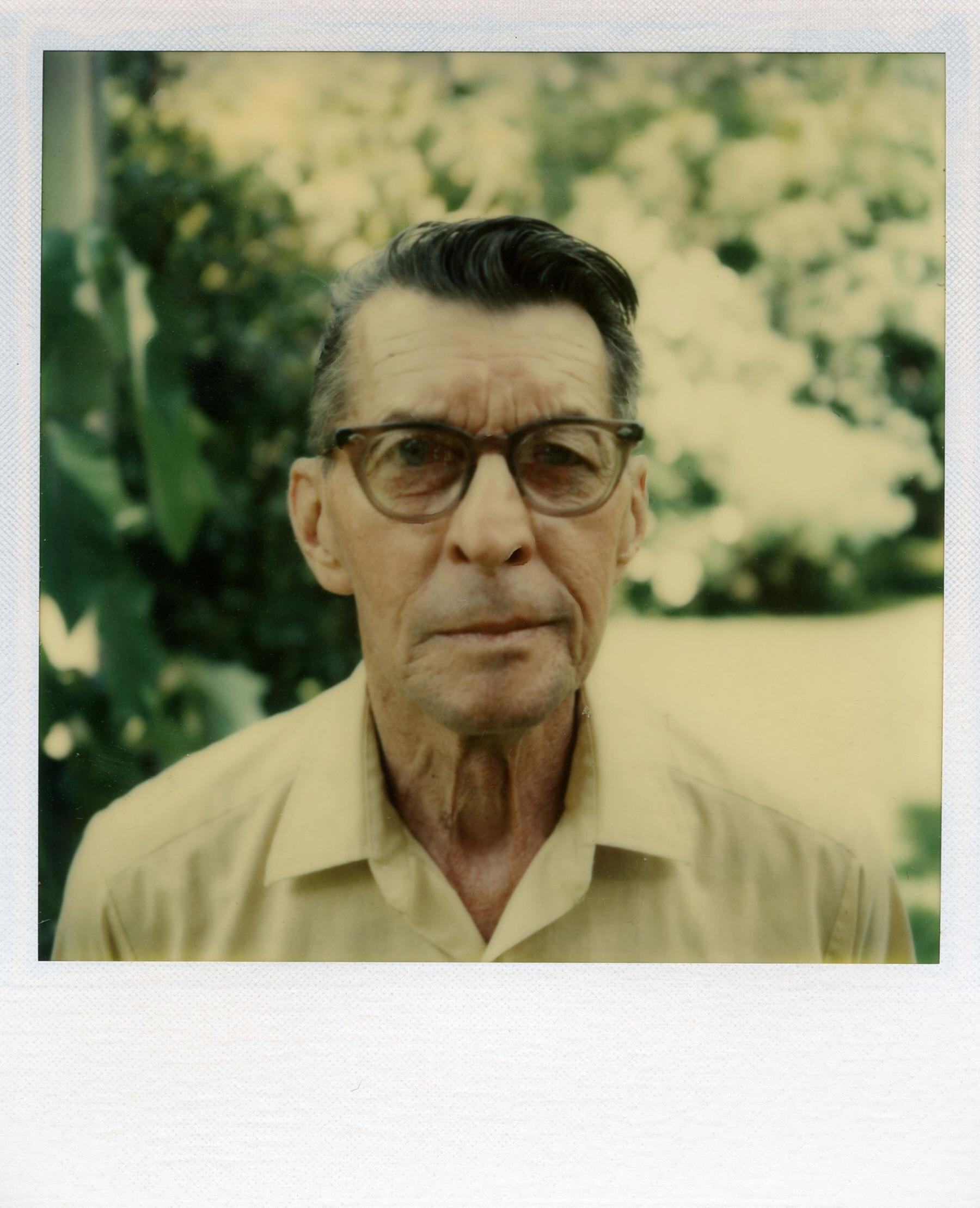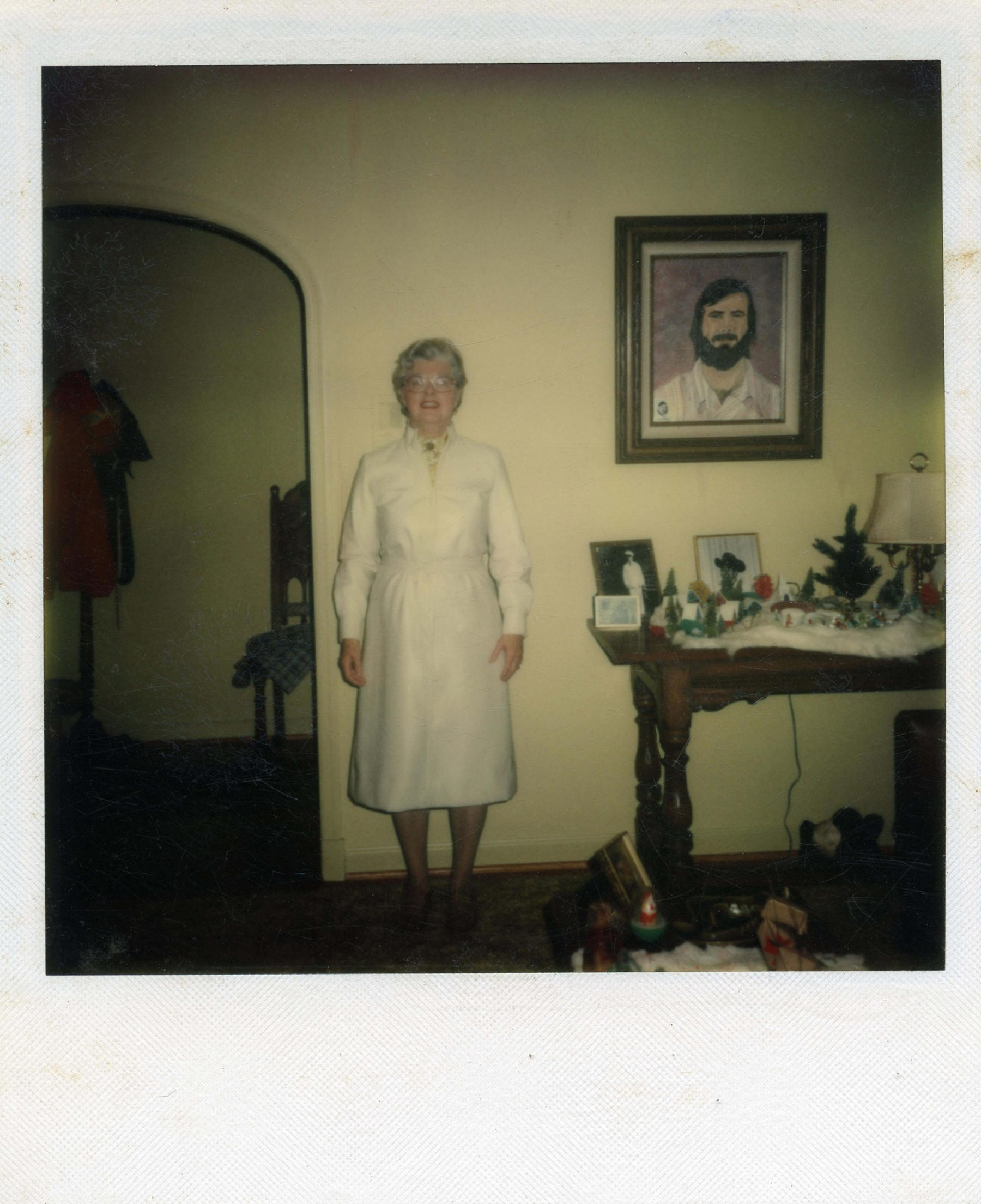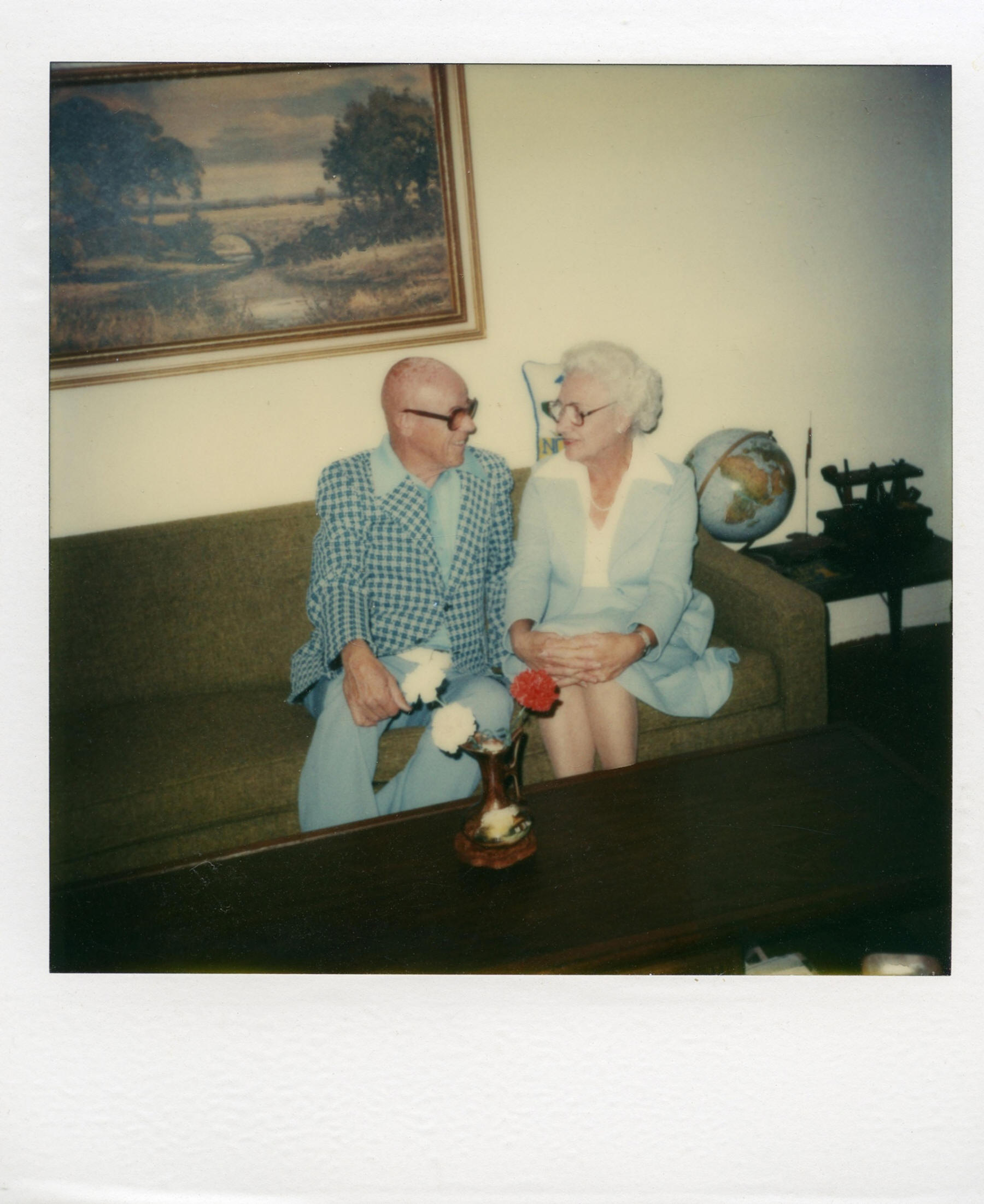|
Vocapedia >
Arts >
Photography >
Cameras > Polaroid

Cover of LIFE magazine dated 10-27-1972
w. logo & pic of Polaroid's Edwin Land
w.
new instant camera;
photo by Co Rentmeester.
Date taken: October 27, 1972
Photographer: Co Rentmeester
Life Images
http://images.google.com/hosted/life/a685634fe49337a6.html

No. 3242
Who are the
Polaroid people?
One man's quest to
solve 6,000 mysteries
G
Monday 17 August 2015 07.00 BST
https://www.theguardian.com/artanddesign/gallery/2015/aug/17/
found-polaroid-people-solve-6000-mysteries-in-pictures

No. 11010
Who are the
Polaroid people?
One man's quest to
solve 6,000 mysteries
G
Monday 17 August 2015 07.00 BST
https://www.theguardian.com/artanddesign/gallery/2015/aug/17/
found-polaroid-people-solve-6000-mysteries-in-pictures

No. 088
Who are the
Polaroid people?
One man's quest to
solve 6,000 mysteries
G
Monday 17 August 2015 07.00 BST
https://www.theguardian.com/artanddesign/gallery/2015/aug/17/
found-polaroid-people-solve-6000-mysteries-in-pictures
The demise of Polaroid’s instant film cameras
USA
https://www.nytimes.com/2008/12/28/
weekinreview/28kimmelman.html
https://www.nytimes.com/slideshow/2008/12/28/
weekinreview/1228_POLAROID_SS_index.html
Polaroid UK / USA
https://www.theguardian.com/artanddesign/
polaroid
https://www.theguardian.com/artanddesign/gallery/2024/dec/13/
dietmar-busse-new-york-photography
https://www.npr.org/2023/05/11/
1174343605/virginia-hid-execution-files-from-the-public-
heres-what-they-dont-want-you-to-se
https://www.nytimes.com/2022/01/06/
style/clifton-mooney-polaroids.html
https://www.theguardian.com/artanddesign/2019/jun/22/
private-polaroids-robby-muller-cinematographer-
arles-like-sunlight-coming-through-clouds
https://www.theguardian.com/artanddesign/2018/sep/18/
strictly-analogue-polaroids-past-present-and-future-a-photo-essay
https://www.nytimes.com/video/
opinion/100000005503617/the-polaroid-job.html
https://www.washingtonpost.com/news/in-sight/wp/2018/02/05/
this-man-collected-6000-orphaned-polaroids-
see-what-hes-doing-to-tell-their-stories/
https://www.theguardian.com/artanddesign/gallery/2016/oct/29/
polaroid-moments-the-art-of-instant-images-in-pictures
https://www.theguardian.com/artanddesign/gallery/2016/sep/14/
oliver-blohm-photographer-polaroids-sturm-und-zwang-in-pictures
https://www.theguardian.com/artanddesign/2016/aug/19/
anatomy-of-an-artwork-warhol-self-portrait-1981
https://www.theguardian.com/film/2016/aug/16/
andrei-tarkovsky-polaroid-photographs-auctioned-bonhams-solaris
http://www.nytimes.com/2016/06/21/
arts/design/champion-of-a-polaroid-behemoth-yields-to-the-digital-world.html
http://www.npr.org/2016/04/10/
469330626/to-access-her-big-boxy-muse-photographer-
set-her-sights-on-allen-ginsberg
http://www.bbc.co.uk/programmes/p03kd3mh - 16/03/2016 GMT
https://www.theguardian.com/commentisfree/2015/dec/28/
gift-polaroid-relationship-mother
http://lens.blogs.nytimes.com/2015/10/20/
rescuing-discarded-images-of-everyday-black-life/
http://www.theguardian.com/artanddesign/gallery/2015/aug/17/
found-polaroid-people-solve-6000-mysteries-in-pictures
http://www.theguardian.com/fashion/2015/jul/29/
andy-warhols-intimate-polaroids-from-divine-to-bianca-jagger
http://www.guardian.co.uk/artanddesign/2012/jan/18/
patti-smith-camera-solo-polaroids
http://www.thedailybeast.com/galleries/2011/08/06/
helmut-newton-polaroids-photos.html
http://www.guardian.co.uk/artanddesign/gallery/2010/may/30/
photography-polaroid
http://www.guardian.co.uk/artanddesign/2010/apr/05/
polaroid-impossible-project-instant-photography
http://www.nytimes.com/2010/02/11/
arts/design/11polaroid.html
http://www.guardian.co.uk/artanddesign/gallery/2009/oct/07/
polaroid-photography-warhol-walker
http://www.independent.co.uk/life-style/gadgets-and-tech/features/
isex-how-pornography-has-revolutionised-technology-1749247.html
- 17 July 2009
20-inch-by-24-inch Polaroid
USA
http://www.nytimes.com/2016/01/06/
arts/design/with-film-supply-dwindling-a-photographer-
known-for-huge-portraits-stares-at-retirement.html
South Africa > Polaroid's ID-2 camera
UK
(it) had a "boost" button to increase the flash
– enabling it to be used to photograph black people
for the notorious passbooks, or "dompas",
that allowed the state to control their movements.
https://www.theguardian.com/artanddesign/2013/jan/25/
racism-colour-photography-exhibition
Corpus of news articles
Arts > Photography > Polaroids
Critic’s Notebook
The Polaroid:
Imperfect, Yet Magical
December 28, 2008
The New York Times
By MICHAEL KIMMELMAN
The next few months will end an era that began six decades ago with a
contraption called the Model 95 camera. That accordion-style machine delivered
instant photography at a price tag equivalent to some $850 today. The SX-70,
which spit out color prints, arrived in 1972. American life during the late 20th
century had found its Boswell.
The demise of Polaroid’s instant film cameras has been coming for years. Digital
technology did it in. The decision this year by the company that Edwin Land
founded to stop manufacturing the film has left devotees who grew up with
Polaroid’s palm-size white-bordered prints bereft. They have signed up in the
thousands as members of SavePolaroid.com. Digital cameras that print instant
pictures have materialized to fill the void, providing a practical substitute.
But as in most affairs of the heart, logic is beside the point.
Cold-blooded blogs during the last year have dished about Polaroid’s leaky
developers and the impossibility of making copies from instant film prints or of
fiddling with them, which, by the way, was precisely why police photographers
long ago cottoned to them for crime scenes and mug shots. A friend the other day
also complained about how Polaroids often came out yellow and, when left on the
rainy porch or stuck onto the refrigerator door along with the shopping lists
and report cards, ended up faded and curled.
All true. One is reminded of the pragmatists’ disdain for long-playing records
when compact disks arrived. Then D.J.’s and audiophiles revived LPs, in part
precisely for the virtues of its inconvenience.
That is to say, LPs, like Polaroids, entailed certain obligating rituals. Igor
Stravinsky near the end of his life spent evenings confined to a chair. He
listened often to Beethoven. His assistant, Robert Craft, would cue the records
up, then, when one side was finished, rise from his seat, carefully flip the
vinyl disk over, place the needle at the beginning, and rejoin the composer, a
simple act of devotion required by the limits of LP technology, endlessly
repeated until it became a routine binding Stravinsky and Craft like father and
son.
I can still picture my own father with his Polaroid camera. “Cheese,” he would
actually say, and the machine would whir before expelling a print with the
negative still attached, requiring the shutterbug to wait a prescribed time
before peeling it off. My father would check his watch, shaking the covered
snapshot as if the photograph were a thermometer. Then at the right moment, with
a surgeon’s delicate hands, he would separate the negative in a single motion
and reveal — well, who knew what.
Because that was part of the beauty of the Polaroid. Mystery clung to each
impending image as it took shape, the camera conjuring up pictures of what was
right before one’s eyes, right before one’s eyes. The miracle of photography,
which Polaroids instantly exposed, never lost its primitive magic. And what
resulted, as so many sentimentalists today lament, was a memory coming into
focus on a small rectangle of film.
Or maybe not. Digital technology now excuses our mistakes all too easily — the
blurry shot of Aunt Ruth fumbling with a 3-wood at the driving range; or the one
of Cousin Jeff on graduation day where a flying Frisbee blocked the view of his
face; or of Seth in his plaid jacket heading to his first social, the image
blanched by the headlight of Burt’s car coming up the driveway; or the pictures
of you beside the Christmas tree where your hair is a mess.
Digital cameras let us do away with whatever we decide is not quite right, and
so delete the mishaps that not too often but once in a blue moon creep onto film
and that we appreciate only later as accidental masterpieces. In fact, the new
technology may be not more convenient but less than Polaroid instant film
cameras were, considering the printers and wires and other electronic gadgets
now required, but at this one thing, the act of destruction, a source of
unthinking popularity in our era of forgetfulness and extreme makeovers, digital
performs all too well. Polaroids, reflecting our imperfectability, reminded us
by contrast of our humanity.
Glossy talismans in unreal colors, as ephemeral as breath on glass, they wreaked
all the more havoc with our emotions for being so unassuming and commonplace.
One of history’s least dewy-eyed photographers, Walker Evans spent his last
years snapping some 2,500 Polaroids. During the early 1970s, to help introduce
its product, Polaroid doled out SX-70s with unlimited film to a few prominent
photographers, Evans among them.
He was having trouble wielding bigger cameras by then, and, clunky though it
could be, the SX-70 gave him a fresh lease on life. Its point-and-shoot
technology nicely dovetailed with his lean, laconic, democratic scrutiny of the
world, stripping photographs down to their bare-bone essentials. It was a
prosaic machine for an art about prosaic things in which, as in the camera
itself, Evans found a kind of grave eloquence.
A contrarian, he also embraced its off-key colors and the fact that many other
photographers didn’t take the everyman device seriously (not yet anyway). Along
with some fish-eyed close-ups of pretty young women he was trying to impress,
Evans composed abstract vignettes and snapped street signs that let him fool
around with words and puns as he had done decades earlier and generally better.
But he also shot great pictures of ready-mades, like the toothy grill of a
junked pink Ford parked in a bunch of weeds, a bittersweet elegy of bygone
America that in his hands stayed blessedly clear of nostalgia.
Other artists came to love Polaroids, of course. Warhol recognized it as the
perfect tool to capture the gaudy, passing glamour of the disco 1970s, not to
mention the genitals of visitors to the Factory, whom he apparently asked to
drop their pants for posterity’s sake. (“It was surprising who’d let me and who
wouldn’t,” he reportedly said.) Conceptual artists like Vito Acconci identified
with its quotidian efficiency and William Wegman made a nice career
photographing Weimaraners he called Man Ray and Fay Ray. David Hockney produced
Cubist collages; Chuck Close, portraits. The paradox of such a mass-market
machine serving elite purposes proved irresistible to many artists and the
Polaroid snapshot became a cliché in high art circles, whose diaristic potential
continues to lure chroniclers of fashion like Dash Snow.
Ultimately, though, it’s the populist tradition that lends the demise of
Polaroid instant film its poignancy: the power of all those ordinary pictures to
salvage forgotten lives — and the finality of the moment after which the mass of
billions of snapshots preserving millions of anonymous instants of happiness or
private consequence ceases to grow and, with us, heads toward oblivion.
In “The Emigrants,” W. G. Sebald’s narrator by chance notices an item in a
Lausanne newspaper about the discovery of a dead Alpine climber, a
long-forgotten man who happened to have been very dear to someone the narrator
once knew and had himself nearly forgotten. The climber’s remains were suddenly
released by a glacier in Switzerland, where he had gone missing 72 years
earlier.
“And so they are ever returning to us, the dead,” Sebald writes. “At times they
come back from the ice more than seven decades later and are found at the edge
of the moraine, a few polished bones and a pair of hobnailed boots.”
Or as a yellowing Polaroid snapshot we dumped into a shoebox one day long ago
and forget in a corner of the attic; or clipped to the back of the sun visor in
the old Buick; or that migrated behind the refrigerator, waiting to be
rediscovered.
The Polaroid: Imperfect,
Yet Magical,
NYT,
28.12.2008,
https://www.nytimes.com/2008/12/28/
weekinreview/28kimmelman.html
Novelties
Instant Digital Prints
(and Polaroid Nostalgia)
April 13, 2008
The New York Times
By ANNE EISENBERG
MILLIONS of families once snapped Polaroid photographs and enjoyed passing
around the newly minted prints on the spot, instead of waiting a week for them
to be developed.
Now, Polaroid wants to conjure up those golden analog days of vast sales and
instant gratification — this time with images captured by digital cameras and
camera phones.
This fall, the company expects to market a hand-size printer that produces color
snapshots in about 30 seconds.
Beam a photograph from a cellphone to the printer and, with a gentle purr, out
comes the full-color print — completely formed and dry to the touch.
The printer, which connects wirelessly by Bluetooth to phones and by cable to
cameras, will cost about $150. The images are 2 inches by 3 inches, the size of
a credit card. The new printers are so lightweight that a Polaroid executive
demonstrating them recently had three tucked unnoticeably into various pockets
of his trim jacket, whipping them out as if he were Harpo Marx.
The printer opens like a compact with a neat, satisfying click. Inside, no
cartridges or toner take up space. Instead, there is a computer chip, a
2-inch-long thermal printhead and a novel kind of paper embedded with
microscopic layers of dye crystals that can create a multitude of colors when
heated.
When the image file is beamed from the camera to the printer, a program
translates pixel information into heat information. Then, as the paper passes
under the printhead, the heat activates the colors within the paper and forms
crisp images.
The unusual paper is the creation of former employees of Polaroid who originated
the process there. They spun off as a separate company, Zink Imaging, in 2005
after Polaroid’s bankruptcy and eventual sale to the Petters Group Worldwide in
Minnetonka, Minn. The Alps Electric Company in Tokyo will make the printers.
The potential market for instant printing of photos captured by phones and
digital cameras is vast and largely untapped, said Steve Hoffenberg, an analyst
at Lyra Research, a market research firm in Newtonville, Mass. “There’s an
explosion in picture taking,” he said, “primarily because of the sheer number of
camera phones out there on a worldwide basis.” Lyra projects shipments of about
880 million camera phones in 2008.
But it may be hard for the new printers to find a niche. About 478 billion
photographs will be taken worldwide in 2008, Mr. Hoffenberg said, most of them
by camera phones, but only a tiny fraction of those clicks will end up as
prints.
“People can just post picture files on a Web page, or e-mail them to other
people,” he said. “These days people have many options.”
The printers might catch on for social occasions like family gatherings, he
said, or among teenagers who enjoy exchanging photos, or among professional
groups like real estate agents who want to hand an instant image to a
prospective home buyer.
The snapshots will cost less than traditional Polaroid prints, which typically
have run at least $1, and often more, during the last decade, said Jim Alviani,
director for business development for Polaroid. The Zink paper for the printer
will sell in 10-packs for $3.99, and in 30-packs for $9.99, so the cost will be
about 33 to 40 cents a sheet.
The rechargeable lithium ion battery that runs the printer will last for about
15 shots.
The prints, which are borderless, have a semigloss finish and an adhesive
backing that can be peeled off if users want to stick them on a locker or a
notebook cover, for instance.
The paper that makes the small printer possible will be used not only with
Polaroid, but also with other brands in the future, said Steve Herchen, the
chief technology officer of Zink, in Bedford, Mass.
The Tomy Company in Tokyo, for example, will embed a Zink-friendly printer
directly within a camera that it plans to distribute, he said. The Foxconn
Technology Group of Taiwan will make this integrated camera-printer.
Zink paper looks like ordinary white photographic paper, but its composition is
different.
“We begin with a plastic web,” Mr. Herchen said, “and then put down our
image-forming materials in multiple thin layers of dye crystals.”
Each 2-by-3-inch print has about 100 billion of these crystals. During printing,
about 200 million heat pulses are delivered to the paper to form the colors.
However ingenious the process, Mr. Hoffenberg of Lyra said, people might still
not be tempted to convert camera clicks into prints.
“Potential markets can exist because they aren’t tapped, but also because they
aren’t actually a market,” he said. “It’s not always evident up front which is
the case.”
Instant Digital Prints
(and Polaroid Nostalgia),
NYT,
13.4.2008,
https://www.nytimes.com/2008/04/13/
technology/13novel.html
Explore more on these topics
Anglonautes > Vocapedia
photography
media > photojournalism
Related > Anglonautes
>
Arts
photography
war photography
photography > galleries
|